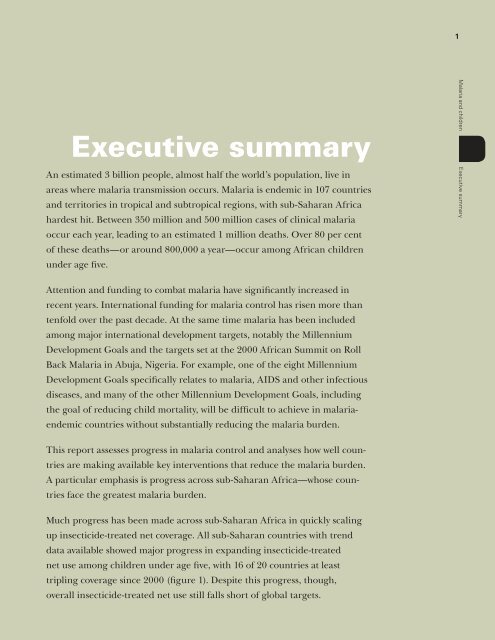Malaria and children: Progress in intervention coverage - Unicef
Malaria and children: Progress in intervention coverage - Unicef
Malaria and children: Progress in intervention coverage - Unicef
You also want an ePaper? Increase the reach of your titles
YUMPU automatically turns print PDFs into web optimized ePapers that Google loves.
1<br />
Executive summary<br />
An estimated 3 billion people, almost half the world’s population, live <strong>in</strong><br />
areas where malaria transmission occurs. <strong>Malaria</strong> is endemic <strong>in</strong> 107 countries<br />
<strong>and</strong> territories <strong>in</strong> tropical <strong>and</strong> subtropical regions, with sub- Saharan Africa<br />
hardest hit. Between 350 million <strong>and</strong> 500 million cases of cl<strong>in</strong>ical malaria<br />
occur each year, lead<strong>in</strong>g to an estimated 1 million deaths. Over 80 per cent<br />
of these deaths—or around 800,000 a year—occur among African <strong>children</strong><br />
under age five.<br />
<strong>Malaria</strong> <strong>and</strong> <strong>children</strong> Executive summary<br />
Attention <strong>and</strong> fund<strong>in</strong>g to combat malaria have significantly <strong>in</strong>creased <strong>in</strong><br />
recent years. International fund<strong>in</strong>g for malaria control has risen more than<br />
tenfold over the past decade. At the same time malaria has been <strong>in</strong>cluded<br />
among major <strong>in</strong>ternational development targets, notably the Millennium<br />
Development Goals <strong>and</strong> the targets set at the 2000 African Summit on Roll<br />
Back <strong>Malaria</strong> <strong>in</strong> Abuja, Nigeria. For example, one of the eight Millennium<br />
Development Goals specifically relates to malaria, AIDS <strong>and</strong> other <strong>in</strong>fectious<br />
diseases, <strong>and</strong> many of the other Millennium Development Goals, <strong>in</strong>clud<strong>in</strong>g<br />
the goal of reduc<strong>in</strong>g child mortality, will be difficult to achieve <strong>in</strong> malariaendemic<br />
countries without substantially reduc<strong>in</strong>g the malaria burden.<br />
This report assesses progress <strong>in</strong> malaria control <strong>and</strong> analyses how well countries<br />
are mak<strong>in</strong>g available key <strong>in</strong>terventions that reduce the malaria burden.<br />
A particular emphasis is progress across sub- Saharan Africa—whose countries<br />
face the greatest malaria burden.<br />
Much progress has been made across sub- Saharan Africa <strong>in</strong> quickly scal<strong>in</strong>g<br />
up <strong>in</strong>secticide-treated net <strong>coverage</strong>. All sub- Saharan countries with trend<br />
data available showed major progress <strong>in</strong> exp<strong>and</strong><strong>in</strong>g <strong>in</strong>secticide-treated<br />
net use among <strong>children</strong> under age five, with 16 of 20 countries at least<br />
tripl<strong>in</strong>g <strong>coverage</strong> s<strong>in</strong>ce 2000 (figure 1). Despite this progress, though,<br />
overall <strong>in</strong>secticide-treated net use still falls short of global targets.
















